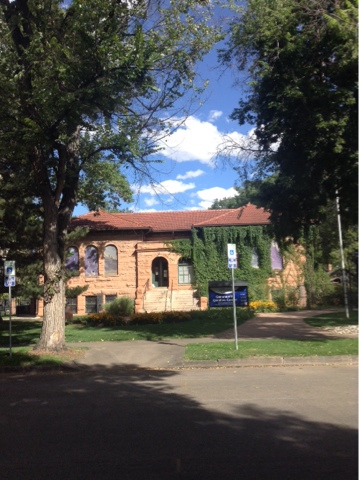The rugged mountains affirmed this was the West, but the traffic was more like the eastern seaboard. This wasn't the quiet rural America that I was seeking. The desert terrain on the fringe of the mountains was packed with housing developments for over 150 miles from Colorado Springs north. "Colorful Colorado" is not only a popular place to visit but also to move to.
The traffic was so thick through the college towns of Boulder and Fort Collins, bicyclists were banned from their main thoroughfares. Boulder at least had a fairly decent bicycle path alternative, but Fort Collins just offered meager sidewalks that didn't always go through. These towns were catering to motorists rather than obliging or encouraging the more sensible means of transportation. Colorado is not as enlightened as one might think, though it does utilize the round-about more than most states.
I was on the sidewalk along Broadway through the heart of Boulder when I came to Pine Street and a prominent sign that pointed to its Carnegie Library off to the left, half a block down the residential street. It is no longer the city's main library but rather a research library for local history with only limited hours. A plaque acknowledged Carnegie for donating $15,000 for its construction in 1906. That was fifty per cent more than his usual grants, allowing for an extra degree of magnificence. The plaque implied Boulder deserved it, as it was known as the "Athens of the West."
The bike rack out front was as noteworthy as the library.
The city of Longmont twenty miles to the north was another burgeoning town that had greatly outgrown its Carnegie. It had been replaced by a huge two-story building with large glass windows all around that was more aesthetically pleasing than many such newer libraries. It gained extra points with a superb collection of bicycle books including a recent biography of Tour winner Luis Ocana, one of the handful who committed suicide, and also Tim Moore's second cycling book, "Gironimo!," on the 1914 Giro d'Italia, in which only eight of its eighty-one starters finished. I would have loved to have stayed and read them both, but I already had them on reserve back in Chicago.
The former Carnegie was right next door. It now housed a local radio station and cable television station. Though it was greatly dwarfed by the new library, it was certainly the more distinguished of the two.
I had thirty-five miles more of nerve-jangling traffic to Fort Collins before I could head off into the peace of the flatlands. Half-way there I was treated to an array of public sculptures in Loveland. There was a tacky strain of hearts painted by local artists, another imitation of the Cows of Chicago, but also some most worthwhile original sculptures as well. The centerpiece was a monstrous "Seawitch" with a price tag of $96,000 on it.
Fort Collins had also outgrown its Carnegie, which was now the "Community Creative Center." It was in a large park where the new library, similar to the one in Longmont, now resided. The old and new made nice companions, though there was no comparison of which had the greater dignity.
My route out of town away from the setting sun was just a couple blocks over on Mulberry. I continued my battle with the traffic for four miles until I crossed over Interstate 25 and then suddenly I had the road all to myself, my first tranquil cycling since coming down out of the mountains into Colorado Springs. There were a few fields of corn ready for harvest that I thought I could camp amongst, but the ground was hard and rutted. Mostly the landscape was grasslands of dried and withered vegetation barely fit for a few stray cattle. I strained to spot the buffalo that once dominated the landscape, but they were long gone. The only trees were around the occasional homestead.
Just before dark I was fortunate to come upon a strand of trees along a creek that provided the privacy I was seeking. They were beyond a barbed wire fence, but a gate had no lock on it nor a "No Trespassing" sign. I only needed to lift a loop of wire over a post to gain entry to another perfectly fine place to rest my bones for the night. There were dried cow patties in the field, but no cows to be seen, just a few squawking magpies in the trees who were either welcoming or protesting my presence. They soon quieted and I had a solid, uninterrupted sleep.







No comments:
Post a Comment